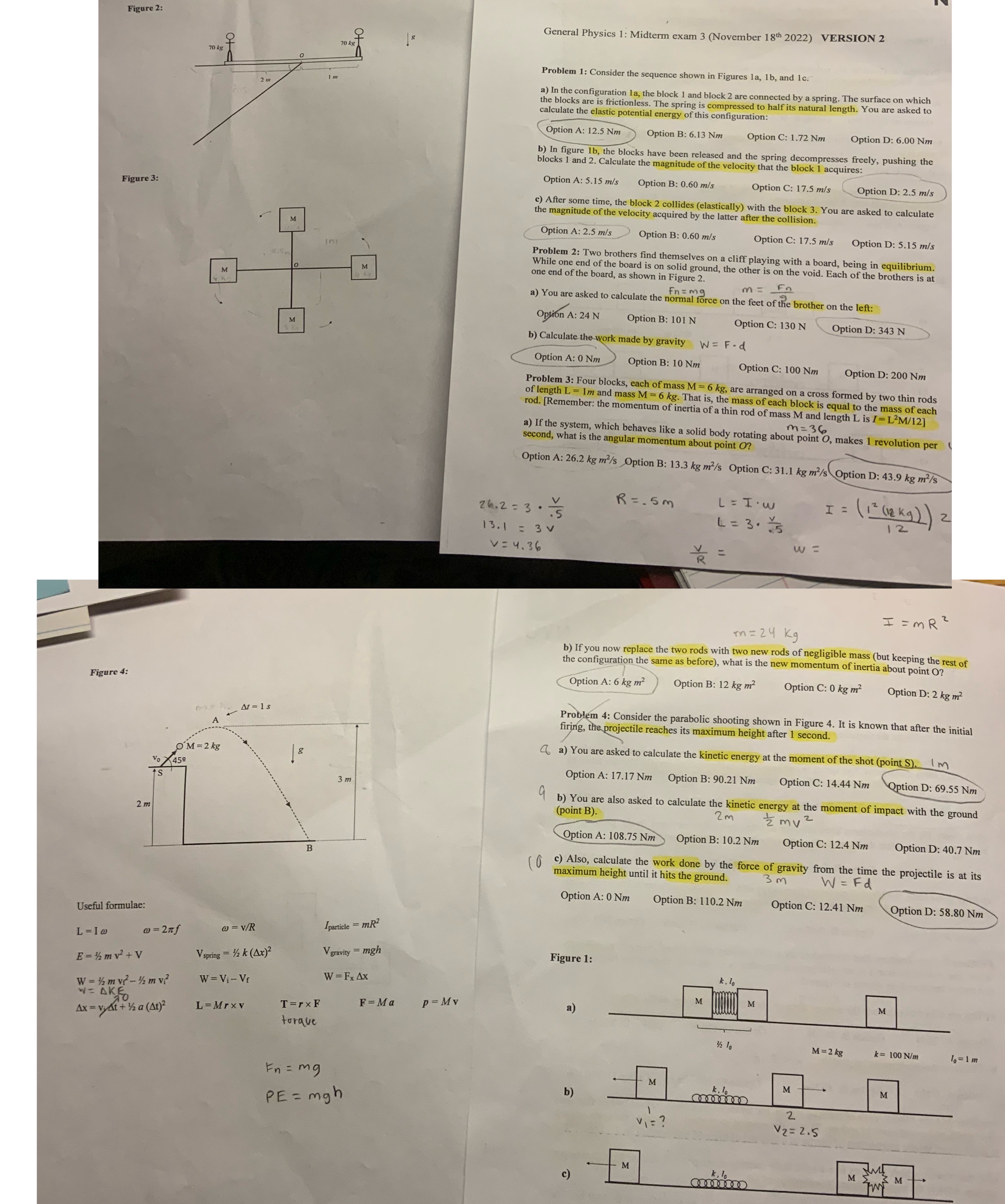Please answer questions 1-4 in detail, the correct answers are already circled, I just have no idea how to do it. Thank you so much in advance.
Figure 2 : General Physics 1: Midterm exam 3 (November 18th 2022) VERSION 2 Problem 1: Consider the sequence shown in Figures la, 1b, and Ic. I m a) In the configuration la, the block 1 and block 2 are connected by a spring. The surface on which the blocks are is frictionless. The la fictionless. The spring is compressed to half its natural length. You are asked to calculate the elastic potential energy of this configuration: Option A: 12.5 Nm Option B: 6.13 Nm Option C: 1.72 Nm Option D: 6.00 Nm b) In figure 1b, the blocks have been released and the spring decompresses freely, pushing the blocks 1 and 2. Calculate the magnitude of the velocity that the block 1 acquires: Option A: 5.15 mls Option B: 0.60 mls Option C: 17.5 mls Option D: 2.5 mls Figure 3: her some time, the block 2 collides (elastically) with the block 3. You are asked to calculate the magnitude of the velocity acquired by the latter after the collision. M Option A: 2.5 mls Option B: 0.60 mls Option C: 17.5 mls Option D: 5.15 mls In Problem 2: Two brothers find themselves on a cliff playing with a board, being in eq eing in equilibrium. While one end of the board is on solid ground, the other is on the void. Each of the brothers is at one end of the board, as shown in Figure 2. M Fn = mg m = ta a) You are asked to calculate the normal force on the feet of the brother on the left: Option A: 24 N Option B: 101 N Option C: 130 N Option D: 343 N M b) Calculate the work made by gravity W = F . d Option A: 0 Nm Option B: 10 Nm Option C: 100 Nm Option D: 200 Nm Problem 3: Four blocks, each of mas cks, each of mass M = 6 kg, are arranged on a cross formed by two thin rods of length L = Im and mass M = 6 kg. That is, the mass of each block is equal to the mass of each rod. [Remember: the momentum of inertia of a thin rod of mass M and length L is 1 = L2M/12 a) If the system, which behaves like a solid body rotating about point O, makes 1 revolution per m= 36 second, what is the angular momentum about point O? Option A: 26.2 kg m /s Option B: 13.3 kg m /s Option C: 31.1 kg m /s Option D: 43.9 kg m2/s R = . 5m L = I. W . .5 I = ( 12 ( 12 kg ) ) L = 3. X5 12 13 . 1 = 3 V V = 4. 36 W = I = MR ? m = 29 kg b) If you now replace the two rods with two new rods of negligible mass (but keeping the rest of he configuration the same as before), what is the new momentum of inertia about point (? Option B: 12 kg m Figure 4: Option A: 6 kg m Option C: 0 kg m Option D: 2 kg m- Problem 4: Consider the parabolic shooting shown in Figure 4. It is known that after the initial firing, the projectile reaches its maximum height after 1 second. ( a) You are asked to calculate the kinetic energy at the moment of the shot (point S). I m OM=2kg Vo X 458 Option A: 17.17 Nm Option B: 90.21 Nm Option C: 14.44 Nm Option D: 69.55 Nm 3 m b) You are also asked to calculate the kinetic energy at the moment of impact with the ground (point B). 2m 2 my 2 2 m Option A: 108.75 Nm Option B: 10.2 Nm Option C: 12.4 Nm Option D: 40.7 Nm R ( ) Also, calculate the work done by the force of gravity from the time the projectile is at its maximum height until it hits the ground. 3 m W = Fd Option A: 0 Nm Option B: 110.2 Nm Option C: 12.41 Nm Option D: 58.80 Nm Useful formulae: particle = mR? L =I@ @ = 2nf @ = V/R V gravity = mgh Figure 1: E = 12mv +V V spring = 1/2 k (4x ) ? W = Fx Ax W = 1/2 m v- 1/2 m vi W = Vi - Ve M P = MV a) M W= AKE F = Ma L = MrxV T = rxF Ax = viAt + 1/2 a (At)2 torque 4/3 10 M= 2kg k = 100 N/m 1=1 m En = mg M b ) M M PE = mgh V 1 = ? V 2 = 2 . 5 M 3 M







